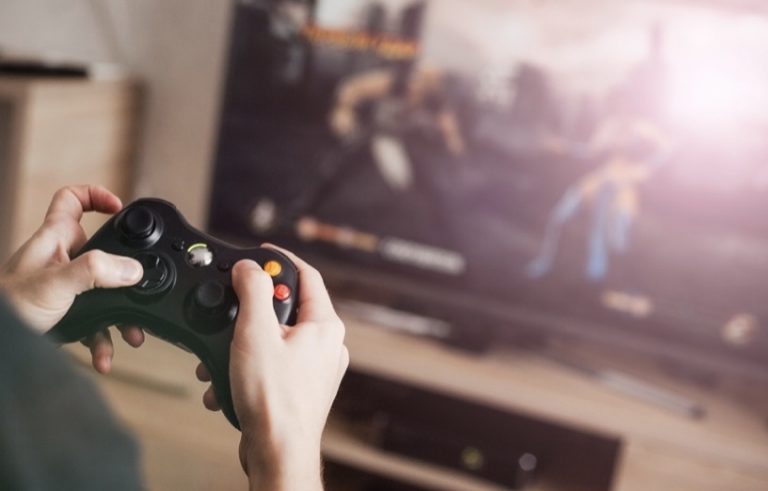Throughout the long months of 2020, when physical activity of any kind—commuting, connecting, and conferencing—came with new challenges, the virtual sphere picked up the slack. Immersive and increasingly low-cost virtual technologies brought the gaming industry to a record $56.9 billion, a 25% increase year over year.
The gaming sphere is getting better and better at upping the stakes, holding players’ attention, and pulling players into a world that feels as real as any other. But gamers are starting to feel that virtual attention taxing their physical health. Repetitive actions—rapid mouse movements, dexterous finger positioning, tapping the same button for hours on end—is making chronic aches and pains an inevitable part of the gaming equation.
Fortunately, an ergonomic set up can reduce some of the damage, allowing gamers to maintain healthier positioning for longer stretches of time. Proper desk, chair, and foot rest equipment can relieve the repetitive load of a seated position. The right mouse, screen, and at-desk measurements can reverse the ramifications of the repetitive actions. And better healthy habits—from taking a timed walk around the block to developing a regular stretching routine—can significantly minimize the risks of logging long hours in front of the game.
There are a few make or break aspects of a good gaming set up: graphics card, process, RAM, storage, the list goes on. But it’s absolutely imperative that the list includes the kind of equipment that supports proper positioning. Setting up the right ergonomic set up won’t be a cost that rivals that of a monitor, or even that of a high-end mouse; there are a number of low-cost solutions, and some adjustments are as easy lowering a desk chair. But the price doesn’t equate with the importance—a healthy at-desk set up should be top of mind for every gaming enthusiast. Below are a few ways to begin.
The Simple Math of an Ideal Gaming Set Up
There is no one size fits all when it comes to proper posture support. A high-end desk chair could be a great investment for one gamer, and for another person of different proportions it could be completely wrong. Before any ergonomic investments are made, it’s important to review the math of your current set up. There are a number offree self-adjustment tools online that allow a user to input their height and adjust their seated position accordingly. Seat height, keyboard height, monitor height, distance from screen, and monitor tilt are all things to consider. A person who is six feet tall should place their monitor roughly 52 inches from the ground, with a 20 to 30 inch later distance between themselves and the screen. Their desk should be positioned such that their keyboard is roughly 28 inches from ground level, and there should be about 18 inches between the ground and their seat.
Speaking of Seat Height
This is an often-overlooked component of ergonomic positioning that is crucial to get right. Our bodies are built to be supported from the ground up. When we spend too much time in a sedentary, seated position, our seated load isn’t distributed evenly. If a person doesn’t have their feet planted firmly on the ground, most of the load is carried by the lower back, the sit-bones, and the hips, putting strain on those muscle groups and repetitively shortening the connective tissue of the hip flexors. Even with proper measurements, foot positioning determines a lot of the silent wear and tear that takes place over time.
Under desk foot rests help people remember the foot position fundamentals. With a slightly elevated surface, the feet are more supported, creating the right foundation for well-distributed seated load. Supported weight then promotes better circulation and leads to back aches, tight hips, and chronic pains. The New York Times named the ErgoFoam the Best Under Desk Foot Rest of 2020. The ErgoFoamis adjustable and comes in various sizes, helping people find a fit that works for them. ErgoFoam also doubles as a rocker; flipped over, the foot rest becomes a tool to infuse more movement into those at-desk hours.
What We Mean When We Say Movement
An obvious tonic for the problems that are associated with too many seated hours is to log less seated hours. But there are days on which that’s much easier said than done. Working from home, sitting down to the dinner table, and fitting in some well-earned recreation and relaxation before the end of the day—the hours add up. Luckily, movement doesn’t always have to come with a capital ‘M,’ and taking up hiking or running sprints on your lunch break isn’t the only way to integrate healthy movement into your day.
Everyone has twenty minutes to spare in a day. Gamers should target necessary stretches to reduce their risk of injury. EsportsHealthcare published a comprehensive list, including finger stretches, hand stretches, forearm stretches, and joint distractions, with videos to demonstrate. For full-fledged gaming days, less is often more; breaking your seated posture with a few mobility exercises every hour achieves much more than the intention to frequent a hot yoga studio.
The name of the healthier game is to engage underused muscle groups, promote healthy circulation, and avoid putting uneven, repetitive loads on the body. Proper desk measurements, under desk foot rest support, and simple movements infused throughout the day will go a long way in achieving that aim. It’s important that gamers make physical health and seated safety a key area of consideration for their gaming strategy. With a keen eye turned toward proper posture habits and ergonomic solutions in place, those seated hours take a significantly lesser toll—let the games begin.



0 Comments